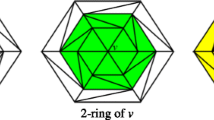Abstract
This paper presents a method for detecting points of interest on 3D meshes. It comprises two major stages. In the first, we capture saliency in the spectral domain by detecting spectral irregularities of a mesh. Such saliency corresponds to the interesting portions of surface in the spatial domain. In the second stage, to transfer saliency information from the spectral domain to the spatial domain, we rely on spectral irregularity diffusion (SID) based on heat diffusion. SID captures not only the information about neighbourhoods of a given point in a multiscale manner, but also cues related to the global structure of a shape. It thus preserves information about both local and global saliency. We finally extract points of interest by looking for global and local maxima of the saliency map. We demonstrate the advantages of our proposed method using both visual and quantitative comparisons based on a publicly available benchmark.






Similar content being viewed by others
Explore related subjects
Discover the latest articles and news from researchers in related subjects, suggested using machine learning.References
Bronstein, M., Kokkinos, I.: Scale-invariant heat kernel signatures for non-rigid shape recognition. In: Proc. CVPR, pp. 1704–1711 (2010)
Castellani, U., Cristani, M., Fantoni, S., Murino, V.: Sparse points matching by combining 3d mesh saliency with statistical descriptors. In: Proc. Eurographics, pp. 643–652 (2008)
Chen, X., Saparov, A., Pang, B., Funkhouser, T.: Schelling points on 3D surface meshes. In: Proc. SIGGRAPH (2012)
Chung, M., Taylor, J.: Diffusion smoothing on brain surface via finite element method. In: IEEE International Symposium on Biomedical Imaging, pp. 432–435 (2004)
Dong, S., Bremer, P.T., Garland, M., Pascucci, V., Hart, J.C.: Spectral surface quadrangulation. In: Proc. SIGGRAPH, pp. 1057–1066 (2006)
Dutagaci, H., Cheung, C., Godil, A.: Evaluation of 3d interest point detection techniques via human-generated ground truth. Vis. Comput. 28, 901–917 (2012)
Gebal, K., Bærentzen, J.A., Aanæs, H., Larsen, R.: Shape analysis using the auto diffusion function. Comput. Graph. Forum 28(5), 1405–1413 (2009)
Gelfand, N., Mitra, N., Guibas, L., Pottmann, H.: Robust global registration. In: Proc. SGP, pp. 197–206 (2005)
Godil, A., Wagan, A.: Salient local 3d features for 3d shape retrieval. In: Proc. SPIE (2011)
Guo, C., Zhang, L.: A novel multiresolution spatiotemporal saliency detection model and its applications in image and video compression. IEEE Trans. Image Process. 19(1), 185–198 (2010)
Hagen, L., Kahng, A.: New spectral methods for ratio cut partitioning and clustering. IEEE Trans. Comput.-Aided Des. Integr. Circuits Syst. 11(9), 1074–1085 (1992)
Hou, X., Zhang, L.: Saliency detection: a spectral residual approach. In: Proc. CVPR, pp. 1–8 (2007)
Hu, J., Hua, J.: Salient spectral geometric features for shape matching and retrieval. Vis. Comput. 25(5), 667–675 (2009)
Koch, C., Poggio, T.: Predicting the visual world: silence is golden. Nat. Neurosci. 2, 9–10 (1999)
Koenderink, J.: The structure of images. Biol. Cybern. 50(5), 363–370 (1984)
Lee, C., Varshney, A., Jacobs, D.: Mesh saliency. In: Proc. SIGGRAPH (2005)
Lévy, B., Zhang, H.R.: Spectral mesh processing. In: SIGGRAPH Courses, pp. 8:1–8:312 (2010)
Li, J., Levine, M.D., An, X., Xu, X., He, H.: Visual saliency based on scale-space analysis in the frequency domain. IEEE Trans. Pattern Anal. Mach. Intell. 99(PrePrints) (2012)
Liu, Y., Zha, H., Qin, H.: Shape topics: a compact representation and new algorithms for 3d partial shape retrieval. In: Proc. CVPR, vol. 2, pp. 2025–2032 (2006)
Mian, A., Bennamoun, M., Owens, R.: On the repeatability and quality of keypoints for local feature-based 3d object retrieval from cluttered scenes. Int. J. Comput. Vis. 89(2), 348–361 (2010)
Novatnack, J., Nishino, K.: Scale-dependent 3d geometric features. In: Proc. ICCV, pp. 1–8 (2007)
Pinkall, U., Polthier, K.: Computing discrete minimal surfaces and their conjugates. Exp. Math. 2(1), 15–36 (1993)
Seo, S., Chung, M., Vorperian, H.: Heat kernel smoothing using Laplace-Beltrami eigenfunctions. In: Proc. MICCAI, pp. 505–512 (2010)
Shilane, P., Funkhouser, T.: Selecting distinctive 3d shape descriptors for similarity retrieval. In: Proc. SMI (2006)
Sipiran, I., Bustos, B.: Harris 3d: a robust extension of the Harris operator for interest point detection on 3d meshes. Vis. Comput. 27(11), 963–976 (2011)
Sun, J., Ovsjanikov, M., Guibas, L.: A concise and provably informative multi-scale signature based on heat diffusion. In: Proc. SGP, pp. 1383–1392 (2009)
Vallet, B., Lévy, B.: Spectral geometry processing with manifold harmonics. In: Computer Graphics Forum, vol. 27, pp. 251–260 (2008)
Zaharescu, A., Boyer, E., Varanasi, K., Horaud, R.: Surface feature detection and description with applications to mesh matching. In: Proc. CVPR, pp. 373–380 (2009)
Zou, G., Hua, J., Dong, M., Qin, H.: Surface matching with salient keypoints in geodesic scale space. Comput. Animat. Virtual Worlds 19(3–4), 399–410 (2008)
Acknowledgements
We gratefully acknowledge funding by HEFCW/WAG on the RIVIC project.
Author information
Authors and Affiliations
Corresponding author
Rights and permissions
About this article
Cite this article
Song, R., Liu, Y., Martin, R.R. et al. 3D point of interest detection via spectral irregularity diffusion. Vis Comput 29, 695–705 (2013). https://doi.org/10.1007/s00371-013-0806-4
Published:
Issue Date:
DOI: https://doi.org/10.1007/s00371-013-0806-4




